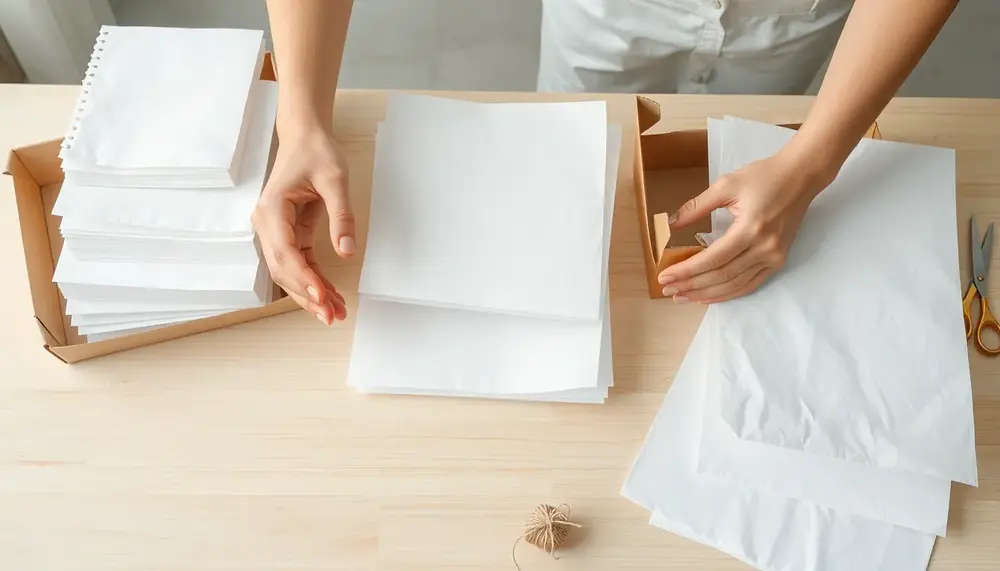Table of Contents:
Introduction: Defining Packaging Tissue Paper for Professional Use
Packaging tissue paper is more than just a decorative layer—it’s a strategic tool for businesses aiming to elevate product presentation and protection. In professional settings, this lightweight, pliable paper serves multiple functions that go far beyond basic wrapping. Whether you’re managing a boutique, an e-commerce brand, or a specialty retail operation, the right tissue paper selection can transform the unboxing experience and reinforce your brand’s identity.
Professionally, packaging tissue paper is engineered for versatility. It’s designed to cushion delicate items, prevent surface scratches, and minimize dust accumulation during storage or transit. But the professional value doesn’t stop at protection. With a vast array of textures, finishes, and customizable options, tissue paper becomes a branding asset—subtly communicating quality, care, and attention to detail from the very first touch.
In today’s competitive market, businesses are leveraging tissue paper not only to safeguard products but also to craft memorable customer experiences. This dual function—practical and promotional—makes packaging tissue paper an essential component of modern packaging strategies, especially for brands that prioritize both aesthetics and functionality in their packaging solutions.
Core Categories of Packaging Tissue Paper and Their Ideal Applications
Packaging tissue paper comes in several specialized categories, each tailored to specific business needs and customer expectations. Understanding these categories is crucial for selecting the right solution for your products and brand message.
- Designer Printed Tissue: Ideal for brands seeking to make a statement, this category features a wide range of colors, patterns, and themes. Use it for seasonal promotions, limited editions, or to reinforce your brand’s personality with every package.
- Pearlescent Tissue: With its subtle shimmer, pearlescent tissue is the go-to for luxury items, jewelry, or high-end fashion. It adds a touch of sophistication and elevates the perceived value of the product inside.
- Tissue Packs: Pre-packaged in convenient sets, these are perfect for fast-paced retail environments or businesses that need quick, consistent packaging solutions. They streamline the packing process and ensure uniformity across shipments.
- Solid Color Tissue: The versatile workhorse of the tissue world, solid color tissue is suitable for almost any product or occasion. Choose it for its adaptability—whether you want to match brand colors or create a clean, minimal look.
- White Tissue: The classic choice for understated elegance, white tissue is favored for its neutrality and professionalism. It’s especially popular in sectors where simplicity and cleanliness are valued, such as cosmetics or tech accessories.
Each category brings unique advantages to the table, allowing businesses to tailor their packaging approach to specific products, occasions, and branding goals. Selecting the right type can mean the difference between a forgettable package and a memorable unboxing experience.
Advantages and Drawbacks of Using Packaging Tissue Paper in Professional Environments
| Pros | Cons |
|---|---|
|
Enhances Product Presentation Elevates the unboxing experience and reinforces brand identity. |
Limited Protection for Heavy Items Not suitable as the sole protective layer for large or fragile products. |
|
Customizable Design Options Wide variety of colors, prints, and finishes for tailored branding. |
Additional Cost Custom printing and specialty finishes increase packaging expenses. |
|
Lightweight & Flexible Easily wraps items of various shapes and sizes, minimizing material waste. |
Not Fully Waterproof Only provides limited moisture barrier; not ideal for all environments. |
|
Supports Sustainable Branding Eco-friendly and recycled options align with environmental values. |
Requires Careful Sourcing Verifying eco-certifications and quality can be time-consuming. |
|
Decreases Product Movement Reduces rattling and protects surfaces from scratches in transit. |
May Require Additional Packaging Often needs to be combined with other materials for optimal protection. |
|
Enables Creative Customer Engagement Can feature QR codes, personal notes, or interactive brand messaging. |
Potential for Waste Unused or excess tissue paper contributes to packaging waste if not managed. |
Color Options, Design Variety, and Branding Potential
Color and design choices in packaging tissue paper aren’t just about aesthetics—they’re a direct extension of your brand’s personality and strategy. With a spectrum ranging from subtle pastels to bold metallics, the options allow for nuanced messaging and targeted customer engagement. Ever considered the psychological impact of color? A vibrant red might spark excitement, while a cool blue can evoke trust and calm—subtle cues that influence how your product is perceived the moment the box is opened.
- Extensive Color Palettes: Modern suppliers offer hundreds of shades, including custom Pantone matching. This makes it possible to align tissue paper precisely with your brand’s visual identity or campaign theme.
- Pattern and Finish Diversity: From polka dots and stripes to abstract art and metallic foils, design options are nearly limitless. Specialty finishes like holographic or pearlescent can add a tactile and visual wow-factor that standard paper simply can’t deliver.
- Branding as Experience: Custom-printed tissue paper, featuring logos, slogans, or even seasonal motifs, turns every package into a subtle marketing tool. It’s not just about recognition—it’s about creating an emotional connection that lingers long after the purchase.
Ultimately, the right combination of color and design transforms packaging tissue paper from a functional necessity into a brand ambassador. When done thoughtfully, it can boost perceived value, enhance shareability on social media, and foster customer loyalty—sometimes all with a single sheet.
How Packaging Tissue Paper Enhances Protection and Customer Experience
Packaging tissue paper delivers a unique dual benefit: it safeguards products while also shaping the customer’s perception from the very first moment. The physical properties of tissue paper—its softness, flexibility, and lightweight nature—allow it to conform closely to any item, reducing the risk of abrasion or minor impact during handling and shipping. This adaptability is especially valuable for items with unusual shapes or delicate surfaces, where standard packaging materials might fall short.
- Layering Capability: Multiple sheets can be layered to provide customized cushioning, making it possible to fine-tune protection for everything from fragile ceramics to luxury textiles.
- Dust and Moisture Barrier: While not fully waterproof, quality tissue paper acts as a first line of defense against dust and light moisture, preserving product freshness and appearance until it reaches the customer.
- Noise Reduction: By wrapping items individually, tissue paper can help prevent the clinking or rattling of contents within a box, creating a sense of care and attention to detail.
From a customer experience perspective, the tactile sensation of unwrapping tissue paper adds a layer of anticipation and delight. This ritual—unfolding, peeling back, and finally revealing the product—creates a memorable, almost ceremonial moment that generic packaging simply can’t replicate. It’s a subtle, yet powerful, way to turn ordinary deliveries into experiences that customers want to share and remember.
Custom Printing and Tailored Solutions for Unique Brand Needs
Custom printing on packaging tissue paper unlocks a level of brand personalization that generic solutions simply can’t match. For businesses with distinctive identities or evolving campaign needs, tailored tissue paper offers a canvas for creativity and strategic messaging. Advanced printing technologies now allow for high-resolution logos, intricate patterns, and even full-color photographic images to be rendered crisply on delicate paper—no smudging, no fading, just sharp, professional results.
- Variable Print Runs: Whether you need a small batch for a seasonal promotion or a large-scale rollout for ongoing use, suppliers can accommodate flexible order sizes. This minimizes waste and aligns with both budget and sustainability goals.
- Material Customization: Choose from recycled fibers, acid-free options, or specialty weights to match your brand’s environmental values or product requirements. Some suppliers even offer compostable or food-safe tissue for niche applications.
- Precision Sizing: Tailored sheet dimensions ensure a perfect fit for your products, reducing excess material and enhancing the unboxing experience. This level of detail is especially valuable for brands with unique packaging shapes or multi-item sets.
- Multi-Layer Printing: For brands seeking extra impact, it’s possible to print different designs on each side of the tissue or incorporate layered effects, adding a surprising twist to the reveal moment.
Collaborating with experienced packaging partners ensures that every aspect—from color fidelity to print alignment—is executed to professional standards. The result? Tissue paper that not only protects but also tells your brand’s story in a way that’s memorable, functional, and unmistakably yours.
Combining Tissue Paper with Other Packaging for Maximum Impact
Pairing tissue paper with other packaging elements is where real packaging magic happens. When done right, this synergy not only elevates product protection but also creates a cohesive, memorable presentation that lingers in the customer’s mind. The trick? Layering and sequencing each component for both function and flair.
- Gift Bags and Boxes: A neatly folded sheet of tissue paper inside a branded bag or rigid box sets the stage for the reveal. It softens the look, hides the contents, and adds a sense of occasion—especially when the tissue color or print echoes the outer packaging.
- Ribbons, Bows, and Seals: Topping off tissue-wrapped items with a ribbon or custom sticker not only secures the paper but also introduces an extra tactile element. This finishing touch can be the difference between a standard package and a keepsake-worthy gift.
- Layered Unboxing: For subscription boxes or curated gift sets, alternating tissue paper with dividers, cards, or inserts creates a multi-stage unboxing journey. Each layer reveals something new, building anticipation and reinforcing brand storytelling.
- Protective Overwraps: For delicate or premium items, using tissue as an inner wrap beneath bubble wrap or foam inserts offers a double layer of care—functional on the outside, beautiful on the inside.
Strategic combinations like these turn ordinary packaging into a branded experience, prompting customers to pause, appreciate, and—if you’re lucky—share their delight online. It’s about more than just looks; it’s about orchestrating a sensory journey from the moment the box is opened.
Professional Services: Guidance, Logistics, and Sourcing
Professional packaging services offer more than just products—they deliver expertise that streamlines every stage of your packaging journey. If you’re aiming for efficiency and consistency, specialized providers can be a game-changer.
- Consultative Guidance: Industry experts analyze your product range, shipping needs, and branding goals to recommend optimal tissue paper types, print methods, and integration strategies. This tailored advice prevents costly missteps and ensures your packaging aligns with both budget and brand image.
- Logistics Management: Coordinated logistics solutions include inventory tracking, warehousing, and just-in-time delivery. For businesses scaling up or operating across multiple locations, this support keeps supply chains smooth and responsive—no more last-minute stockouts or over-ordering headaches.
- Sourcing Networks: Established providers leverage global sourcing relationships to secure quality materials at competitive rates. They can also navigate import regulations, certifications, and eco-standards, so you’re not left guessing about compliance or sustainability claims.
- Sampling and Prototyping: Before committing to a full order, you can request samples or prototypes to evaluate print quality, material feel, and fit. This step minimizes risk and helps fine-tune your final selection.
Partnering with professionals means you’re not just buying tissue paper—you’re investing in a seamless, scalable process that adapts as your business evolves.
Key Business Sectors That Benefit from Packaging Tissue Paper
Packaging tissue paper has become indispensable across a surprising range of industries, each leveraging its unique properties for distinct business objectives. The following sectors stand out for their innovative and strategic use of tissue paper:
- Luxury Retail: High-end boutiques and designer brands use tissue paper to underscore exclusivity and meticulous care, often incorporating custom textures or limited-edition prints to enhance the sense of luxury.
- Jewelry and Accessories: Delicate items like watches, earrings, and sunglasses require gentle handling; tissue paper acts as a non-abrasive layer that protects finishes and gemstones during storage and transit.
- Cosmetics and Beauty: Beauty brands use tissue paper to reinforce hygiene and freshness, while also signaling attention to detail in premium gift sets or influencer mailers.
- Food and Gourmet: Specialty food shops and gourmet gift services opt for food-safe, acid-free tissue to wrap chocolates, pastries, or artisanal products, maintaining both presentation and compliance with safety standards.
- Apparel and Footwear: Fashion retailers rely on tissue paper to prevent creasing and maintain garment shape, especially for delicate fabrics or luxury shoes.
- Corporate Gifting: Companies providing branded gifts or promotional kits often include tissue paper to add a professional, cohesive touch—crucial for first impressions in B2B relationships.
- Art, Antiques, and Collectibles: Galleries and auction houses wrap valuable pieces in acid-free tissue to protect against dust, fingerprints, and environmental damage, ensuring items arrive in pristine condition.
Each of these sectors demonstrates how thoughtful use of packaging tissue paper can address industry-specific challenges, from regulatory compliance to brand differentiation, making it a versatile tool for businesses seeking both function and finesse.
Practical Examples: Tissue Paper in E-Commerce, Retail, and Gift Wrapping
Real-world applications of packaging tissue paper highlight its adaptability and impact across various business models. Let’s get straight to the nitty-gritty—how do brands actually use tissue paper to solve practical challenges and delight customers?
- E-Commerce: Online retailers often use tissue paper to separate and organize multiple items within a single shipment, reducing confusion and minimizing returns due to mixed-up orders. Some e-commerce brands even include a surprise printed message or QR code on the tissue, guiding customers to exclusive online content or loyalty programs—turning unboxing into a digital touchpoint.
- Retail: Brick-and-mortar stores frequently offer complimentary tissue wrapping at checkout, which can be a subtle upsell driver. For example, eco-conscious retailers sometimes use recycled tissue as a visible sign of their sustainability commitment, which resonates with green-minded shoppers and differentiates them from competitors.
- Gift Wrapping: Event planners and specialty gift shops leverage tissue paper for layered, color-coordinated wrapping schemes—think weddings, corporate events, or holiday bundles. By mixing translucent and opaque sheets, they create depth and intrigue, while a small branded insert or handwritten note tucked between layers adds a personalized flourish that’s tough to replicate with standard gift wrap.
These practical examples show that tissue paper isn’t just a background player—it’s a flexible tool for organization, branding, and customer engagement, all rolled into one unassuming sheet.
Conclusion: Making the Most of Packaging Tissue Paper for Business Success
Unlocking the full potential of packaging tissue paper requires a mindset that goes beyond the basics. Forward-thinking businesses are now integrating data-driven insights—such as customer feedback on unboxing experiences or social media engagement metrics—to refine their tissue paper strategies. This approach allows for rapid adaptation to trends and customer preferences, ensuring packaging remains fresh and relevant.
- Leverage seasonal and limited-edition designs to create urgency and exclusivity, driving repeat purchases and word-of-mouth referrals.
- Incorporate QR codes or NFC tags directly onto tissue paper for interactive campaigns, offering instant access to product tutorials, brand stories, or exclusive offers.
- Prioritize sustainable sourcing by selecting suppliers with transparent supply chains and verifiable eco-certifications, which not only supports brand values but also appeals to environmentally conscious consumers.
- Test and iterate by piloting new colors, finishes, or messaging in small batches before scaling up, minimizing risk and maximizing creative impact.
Ultimately, the most successful brands treat packaging tissue paper as a dynamic branding asset—one that evolves with their business goals and customer expectations. Staying agile, innovative, and attentive to detail will ensure tissue paper remains a powerful lever for differentiation and customer loyalty in any competitive landscape.
FAQ about Professional Packaging Tissue Paper
What is packaging tissue paper and why is it used professionally?
Packaging tissue paper is a lightweight, pliable paper designed to protect and present products attractively in professional packaging. It cushions delicate items, prevents scratches and dust, enhances product presentation, and plays a key role in brand communication by improving the unboxing experience.
What are the main categories of packaging tissue paper available?
The core categories include Designer Printed Tissue, Pearlescent Tissue, Tissue Packs, Solid Color Tissue, and classic White Tissue. Each type is tailored for specific branding, product protection, or visual impact, allowing businesses to choose according to their needs and image.
How can packaging tissue paper reinforce branding efforts?
With extensive color palettes, customizable designs, and high-resolution printing options, packaging tissue paper can feature logos, slogans, or unique motifs. This transforms each package into a subtle marketing tool, creates memorable experiences, and boosts brand recognition and loyalty.
What are the professional advantages and challenges of using tissue paper in packaging?
Advantages include elevated presentation, customization, sustainability options, and flexible use for various shapes. Challenges involve limited protection for heavy or fragile items, the need for supplementary packaging, potential additional costs, and the importance of responsible sourcing to avoid unnecessary waste.
Which business sectors benefit most from packaging tissue paper?
Sectors such as luxury retail, jewelry, cosmetics, gourmet food, apparel, corporate gifting, and art or antique industries leverage tissue paper to protect goods, elevate brand image, and create positive unboxing experiences that meet both compliance and aesthetic standards.






